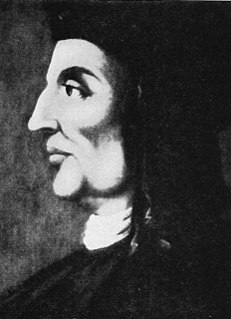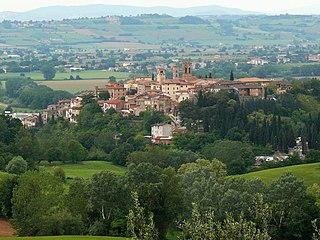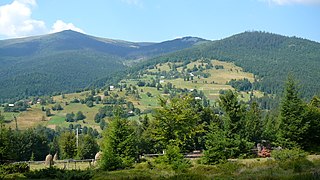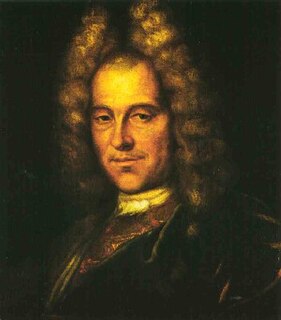
Girolamo Alessandro Frescobaldi was a musician from the Duchy of Ferrara, in what is now northern Italy. He was one of the most important composers of keyboard music in the late Renaissance and early Baroque periods. A child prodigy, Frescobaldi studied under Luzzasco Luzzaschi in Ferrara, but was influenced by a large number of composers, including Ascanio Mayone, Giovanni Maria Trabaci, and Claudio Merulo. Girolamo Frescobaldi was appointed organist of St. Peter's Basilica, a focal point of power for the Capella Giulia from 21 July 1608 until 1628 and again from 1634 until his death.

Gioseffo Zarlino was an Italian music theorist and composer of the Renaissance. He was possibly the most famous European music theorist between Aristoxenus and Rameau, and made a large contribution to the theory of counterpoint as well as to musical tuning.
Luzzasco Luzzaschi was an Italian composer, organist, and teacher of the late Renaissance. He was born and died in Ferrara, and despite evidence of travels to Rome it is assumed that Luzzaschi spent the majority of his life in his native city. He was a skilled representative of the late Italian madrigal style, along with Palestrina, Wert, Monte, Lassus, Marenzio, Gesualdo and others.
Fr. Tomás de Santa María O.P. was a Spanish music theorist, organist and composer of the Renaissance. He was born in Madrid but the date is highly uncertain; he died in Ribadavia. Little is known about his life except that he joined the Dominican order of friars in 1536, he was employed as an organist in various locales in mid-century, and he published his major work, Arte de tañer fantasía, in Valladolid in 1565.

The Venetian polychoral style was a type of music of the late Renaissance and early Baroque eras which involved spatially separate choirs singing in alternation. It represented a major stylistic shift from the prevailing polyphonic writing of the middle Renaissance, and was one of the major stylistic developments which led directly to the formation of what is now known as the Baroque style. A commonly encountered term for the separated choirs is cori spezzati—literally, separated choirs.

Claudio Merulo was an Italian composer, publisher and organist of the late Renaissance period, most famous for his innovative keyboard music and his ensemble music composed in the Venetian polychoral style. He was born in Correggio and died in Parma. Born Claudio Merlotti, he Latinised his surname when he became famous in Venetian cultural clubs.

In music history, the Venetian School was the body and work of composers working in Venice from about 1550 to around 1610. The Venetian polychoral compositions of the late sixteenth century were among the most famous musical events in Europe, and their influence on musical practice in other countries was enormous. The innovations introduced by the Venetian school, along with the contemporary development of monody and opera in Florence, together define the end of the musical Renaissance and the beginning of the musical Baroque.
Baldassare Donato was an Italian composer and singer of the Venetian school of the late Renaissance. He was maestro di cappella of the prestigious St. Mark's Basilica at the end of the 16th century, and was an important figure in the development of Italian light secular music, especially the villanella.
Annibale Padovano was an Italian composer and organist of the late Renaissance Venetian School. He was one of the earliest developers of the keyboard toccata.
Gioseffo Guami was an Italian composer, organist, violinist and singer of the late Renaissance Venetian School. He was a prolific composer of madrigals and instrumental music, and was renowned as one of the finest organists in Italy in the late 16th century; he was also the principal teacher of Adriano Banchieri.

Johann Caspar Kerll was a German baroque composer and organist. He is also known as Kerl, Gherl, Giovanni Gasparo Cherll and Gaspard Kerle.
The year 1610 in music involved some significant events.
Johann Ulrich Steigleder was a German Baroque composer and organist. He was the most celebrated member of the Steigleder family, which also included Adam Steigleder (1561–1633), his father, and Utz Steigleder, his grandfather.

Fiori musicali is a collection of liturgical organ music by Girolamo Frescobaldi, first published in 1635. It contains three organ masses and two secular capriccios. Generally acknowledged as one of Frescobaldi's best works, Fiori musicali influenced composers during at least two centuries. Johann Sebastian Bach was among its admirers, and parts of it were included in the celebrated Gradus ad parnassum, a highly influential 1725 treatise by Johann Joseph Fux which was in use even in the 19th century.
Ercole Pasquini was an Italian composer and organist.
Liuwe Tamminga is a Dutch organist and harpsichordist, known for his performances of Italian Early Music.














